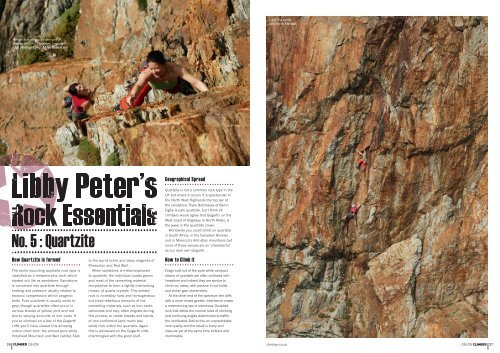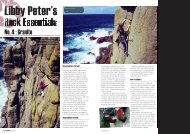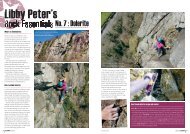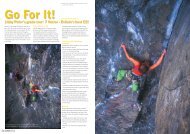Create successful ePaper yourself
Turn your PDF publications into a flip-book with our unique Google optimized e-Paper software.
<strong>Libby</strong> and Meilee<br />
worshiping The Sun.<br />
Meilee Rafe placing a sinker wire in<br />
Icarus (HVS 5a), Rhoscolyn, Anglesey.<br />
All photography: Mike Robertson<br />
<strong>No</strong>. 5 : <strong>Quartzite</strong><br />
How <strong>Quartzite</strong> is formed<br />
............................<br />
The exotic sounding quartzite rock type is<br />
classified as a metamorphic rock, which<br />
started out life as sandstone. Sandstone<br />
is converted into quartzite through<br />
heating and pressure usually related to<br />
tectonic compression within orogenic<br />
belts. Pure quartzite is usually white to<br />
grey, though quartzites often occur in<br />
various shades of yellow, pink and red<br />
due to varying amounts of iron oxide. If<br />
you’ve climbed on a few of the Gogarth<br />
cliffs you’ll have viewed this amazing<br />
colour chart from the almost pure white<br />
Holyhead Mountain and Wen (white) Slab<br />
to the burnt ochre and deep magenta of<br />
Rhoscolyn and Red Wall.<br />
When sandstone is metamorphosed<br />
to quartzite, the individual quartz grains<br />
and most of the cementing material<br />
recrystallize to form a tightly interlocking<br />
mosaic of quartz crystals. This welded<br />
rock is incredibly hard and homogeneous<br />
but small rebellious amounts of the<br />
cementing materials, such as iron oxide,<br />
carbonate and clay, often migrate during<br />
this process to create streaks and bands<br />
of non-conformist (and much less<br />
solid) rock within the quartzite. Again<br />
this is witnessed on the Gogarth cliffs<br />
intermingled with the good stuff.<br />
Geographical Spread<br />
............................<br />
<strong>Quartzite</strong> is not a common rock type in the<br />
UK but where it occurs it is spectacular. In<br />
the <strong>No</strong>rth West Highlands the top tier of<br />
the sandstone Triple Buttresses of Beinn<br />
Eighe is pale quartzite, but I think all<br />
climbers would agree that Gogarth, on the<br />
West coast of Anglesey in <strong>No</strong>rth Wales, is<br />
the jewel in the quartzite crown.<br />
Worldwide you could climb on quartzite<br />
in South Africa, in the Canadian Rockies<br />
and in Morocco’s Anti-atlas mountains but<br />
none of these venues are as ‘characterful’<br />
as our dear own Gogarth.<br />
How to Climb it<br />
............................<br />
Crags built out of the pure white compact<br />
strains of quartzite are often confused with<br />
limestone and indeed they are similar to<br />
climb on; steep, with positive in-cut holds<br />
and sinker gear placements.<br />
At the other end of the spectrum the cliffs<br />
with a more mixed genetic inheritance create<br />
a mesmerising sea of weirdness. Sculpted<br />
rock that defies the normal rules of climbing<br />
and confusing angles determined to baffle<br />
the uninitiated. Add to this an unpredictable<br />
rock quality and the result is scary and<br />
insecure yet at the same time brilliant and<br />
memorable.<br />
26<br />
05|09<br />
climber.co.uk 05|09 27
The chaotic looking Llawder wall of Rhoscolyn is<br />
in fact one of the more solid and normal feeling<br />
Gogarth quartzite crags.<br />
Lou contemplates the<br />
next delicate step of the<br />
unearthly space walk<br />
that is The Moon (E3 5c),<br />
Yellow Wall, Gogarth.<br />
So you need to adapt your climbing style<br />
according to the nature of the cliff or route<br />
that you’re on at the time. On the solid<br />
quartzite cliffs you can crank away to your<br />
hearts content without worrying about the<br />
holds parting company with the cliff. These<br />
steep climbs respond well to a positive and<br />
dynamic approach.<br />
However, once on the softer or more<br />
brittle cliffs you need to avoid pulling hard<br />
on small flakes and avoid hanging all you<br />
weight on the tempting jug like horns,<br />
snappy holds are commonplace. Instead<br />
try to spread your weight over a big area,<br />
don’t pull hard but push and weave and<br />
use forces of levitation rather than<br />
hard pulling.<br />
The Sun and The Moon, featured in the<br />
photos here, sum up these contrasting<br />
styles; steep secure laybacking and<br />
jamming with excellent gear versus ledge<br />
shuffling on dusty holds with some loose<br />
rock and less obvious runners.<br />
One of the peculiarities of the Gogarth<br />
cliffs is the changeability of the rock quality<br />
during the course of a route, so always be<br />
ready to change your style if you suspect<br />
you’ve hit a less solid section.<br />
How to get gear in it<br />
............................<br />
You’ve probably heard of a Yosemite style<br />
big-wall rack, well a Gogarth rack is not<br />
dissimilar. Take lots of everything and<br />
keep on placing it, this’ll compensate<br />
for the dubious rock and unorthodox<br />
placements. Sometimes you can stare at a<br />
chunk of rock in horror seeing no obvious<br />
places for gear, at such times you need to<br />
adopt a creative approach, bunch runners<br />
and make liberal use of spikes and<br />
threads. A Gogarth rack should include at<br />
least a full set of cams as well as nuts and<br />
lots of extra slings. The skinny ones can<br />
be really useful for tiny holes to thread<br />
and horn like spikes.<br />
Special features and<br />
particular hazards<br />
............................<br />
Top outs – are rarely friendly, the crag<br />
top either ends abruptly but with scarce<br />
placements or merge into the hillside so<br />
you find yourself on a steep grass exit.<br />
Always place a runner before you exit the<br />
better rock, alert your belayer and press on<br />
with extreme care.<br />
Belays – place several anchors to<br />
compensate for poor rock quality and less<br />
than perfect placements. The same goes<br />
for runners. Use the rope in the belay<br />
rather than simply using slings to make it<br />
all a bit more dynamic.<br />
Cams in dusty or flaky cracks – are<br />
common and it’s virtually impossible to<br />
gauge their holding power. Treat them with<br />
suspicion and place lots of them.<br />
Best Loved Crags and routes<br />
............................<br />
This list has to start with Dream. A Dream<br />
of White Horses, HVS 5a on Wen Slab is a<br />
journey of beauty and route finding genius.<br />
Once nominated by Rock and Ice as one<br />
of the top 25 climbs in the World, it rarely<br />
dissapoints<br />
• Rhoscolyn – Symphony Crack, a delightful<br />
and rare Diff,<br />
• Rhoscolyn - The Sun, E3 5c, gorgeous.<br />
• Holyhead Mountain – King Bee Crack, HVS<br />
5a, always tough always enjoyable.<br />
• Castell Helen – Lighthouse Arête, VS 4c, a<br />
gentle introduction to the Gogarth<br />
sea-cliff experience.<br />
• Upper Tier –The Strand, E2 5b, has stood<br />
the test of time, take your place in the<br />
queue.<br />
• Main Cliff – Gogarth, E1 5b, a marvellous<br />
journey that unsettles many strong<br />
leaders.<br />
• Yellow Wall – The Moon, E3 5c, as brilliant<br />
as everyone says!<br />
• Red Wall – Red Wall, E2 5b is a good<br />
place to start on this brilliant but baffling<br />
and serious cliff. Once you get a taste for<br />
it you’ll be addicted, be warned!<br />
• Mousetrap Zawn – Mousetrap, E2 5c,<br />
confusing route finding, insecure rock<br />
and poor gear but nonetheless<br />
absolutely fantastic!<br />
Getting up close to quartzite.<br />
<strong>Libby</strong> has been<br />
climbing for<br />
over 20 years,<br />
she’s a qualified<br />
Mountaineering<br />
Instructor and<br />
IFMGA Guide and is<br />
the author of Rock<br />
Climbing – Essential Skills and Techniques<br />
published by MLTUK and recently produced<br />
Get Out On Rock – the definitive instructional<br />
DVD. Her base is <strong>No</strong>rthWales from where<br />
she runs the guiding outfit Llanberis<br />
Guides (www.llanberisguides.com)<br />
Lou Neill pulling into the fiery corner of<br />
The Sun (E3 5c), Rhoscolyn, Anglesey.<br />
28 05|09<br />
climber.co.uk 05|09 29






